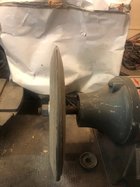I usually use a Sorby proedge for all my sharpening. About a year ago, I bought a Rikon 1hp slow speed grinder and the wolverine setup. I tried it with the original white wheels, but could not get them balanced. About 4 months ago I bit the bullet and got two cbn wheels from wood turners wonders. One wide 180 grit; and one radius 350 grit. I found the 350 heats up metal pretty quick, and does not really put a burr on scrapers. The 180 seems to be a better choice for general purpose. What grit wheel is good for putting a burr on scrapers?
I'm finding the proedge to be more to my liking for general sharpening. On that machine, I use a 120 grit ceramic belt, and a trizac belt (600 grit) for touching up gouges.
I have all hss tools, one v10 gouge, a few m2 cryo tools, and a mess of m42.
I'm finding the proedge to be more to my liking for general sharpening. On that machine, I use a 120 grit ceramic belt, and a trizac belt (600 grit) for touching up gouges.
I have all hss tools, one v10 gouge, a few m2 cryo tools, and a mess of m42.

